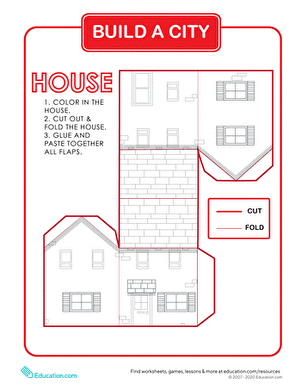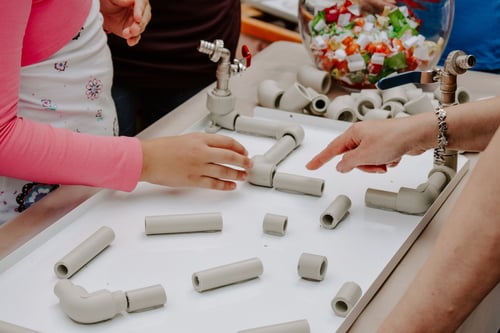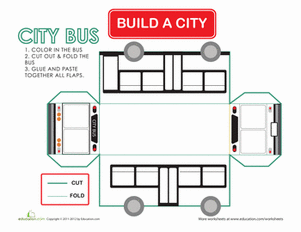Science project
Build an Insect Model
Bring all of those really bad horror movies to life by creating a giant insect! But your insect will serve the powers of good—good science, that is.
Insects come in many different shapes and sizes. A grasshopper is an insect, and so are bees, flies and ants. Animals such as snails and centipedes, however, fall into the larger category of invertebrates—animals without backbones—but they are not insects. Insects have very specific body parts. In this activity, you’ll learn about these body parts by creating your own giant insect.
An insect’s body has three parts: a head, thorax, and abdomen. The insect’s head is similar to ours in some ways. For instance, it contains what we’d call the insect’s brain, even though other parts of the insect are also responsible for storing information and controlling the insect’s movement. The eyes are also located on the head, although insect eyes are often quite different from human eyes. Insects often have compound eyes made up of many different parts that allow the insect to see in many different directions. An insect’s head has stalk-like structures called antennae that are used for feeling and smelling. Different insects have different ways of eating, but an insect’s mouthparts (mandibles) are also on its head.
The thorax is the name for the middle part of the insect’s body where the legs and wings are attached. Insects all have six legs. Think of the thorax as a muscular box that provides the structures needed to move the insect’s legs and wings.
The insect’s six legs are attached to the thorax in three pairs. Like humans, insects have different parts of their legs. The coxa is the part that’s attached the thorax, followed by another small part, the trochanter. The coxa is similar to the human hip and is a moving joint part. The insect’s femur comes after the trochanter. This is a large, muscular part of the insect’s leg, and it’s responsible for movements like hopping. The insect’s tibia and then the tarsus are thinner parts of the legs that may have “brushes” to help the insect clean off or may have little hooks on the end to help the insect move or hold on to things.
The insect’s abdomen is the third and last part of the insect’s body. Like our abdomen, this part of the insect is where many of its organs are located. The insect’s stomach and reproductive organs are located in its abdomen. Insects don’t have lungs, but they do have holes called spiracles that they use to breathe. These spiracles are located under the insect’s thorax and abdomen.

Problem
Build a model of an insect.
Materials
- 3 Oval balloons (or 2 oval balloons and 1 oblong balloon)
- Clear plastic sheet
- Old newspaper
- 2 Cups of flour
- Spoon
- Water
- 1 Tablespoon of salt
- Bowl
- 8 Pipe cleaners
- Acrylic craft paints
- Permanent markers
- Masking tape
- Crazy glue
Procedure
- Do a quick internet search to find a big picture of the kind of insect you want to make.
- Inflate one of the balloons to make the insect’s head. Inflate a second one to make a thorax. Usually this is a little larger than the head. Finally, inflate a third balloon to create an abdomen, which should be bigger than the thorax.
- Now you’re ready to attach these body parts. Connect the head to the thorax with a piece of masking tape. Do the same when you connect the thorax and the abdomen.
- Mix two cups of flour and one tablespoon of salt with two cups of water in a bowl until the mixture is free of lumps and feels like a thin paste.
- Tear your newspaper into thin strips that are around half an inch wide.
- Draw the newspaper strips through the bowl of flour paste until they are lightly covered, and then wrap a strip around the balloons. Continue until all of the balloons are covered in paper mache.
- Let the insect dry for one or two nights until it feels crunchy instead of damp. Add a second coat of paper mache at this time if you’d like it to be a little sturdier.
- When you’ve added the last batch of paper to the insect and it feels completely dry, dip one end of each pipe cleaner into crazy glue. Place two pipe cleaners on the head. These are the antennae. Place six of them in three pairs attached to the thorax to make the legs.
- Finally, if your insect has wings, draw the wings on the piece of plastic and cut them out. Decorate them with that particular insect’s wing patterns, and then use crazy glue to attach them to the thorax as well.
Education.com provides the Science Fair Project Ideas for informational purposes only. Education.com does not make any guarantee or representation regarding the Science Fair Project Ideas and is not responsible or liable for any loss or damage, directly or indirectly, caused by your use of such information. By accessing the Science Fair Project Ideas, you waive and renounce any claims against Education.com that arise thereof. In addition, your access to Education.com's website and Science Fair Project Ideas is covered by Education.com's Privacy Policy and site Terms of Use, which include limitations on Education.com's liability.
Warning is hereby given that not all Project Ideas are appropriate for all individuals or in all circumstances. Implementation of any Science Project Idea should be undertaken only in appropriate settings and with appropriate parental or other supervision. Reading and following the safety precautions of all materials used in a project is the sole responsibility of each individual. For further information, consult your state's handbook of Science Safety.













